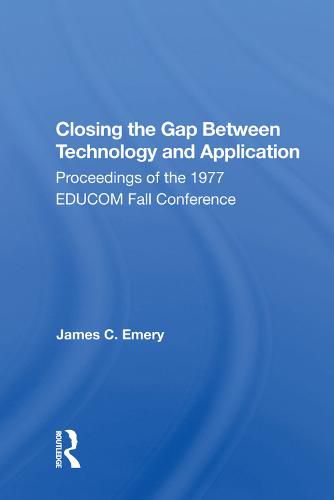Readings Newsletter
Become a Readings Member to make your shopping experience even easier.
Sign in or sign up for free!
You’re not far away from qualifying for FREE standard shipping within Australia
You’ve qualified for FREE standard shipping within Australia
The cart is loading…






This comprehensive study of five major areas of computer application in higher education presents the viewpoints of both purveyors and users of computer technology. The material is based on the EDUCOM 1977 Fall Conference. In the initial chapters of the book, Peter Roll and C. A, Conover offer a general perspective on the use of computing in higher education, noting that the use of small machines in a distributed fashion is changing the organization and application of computers on campus today. In succeeding chapters, the highlighted areas-office automation, distributed academic computing, distributed administrative computing, instructional systems, and information resources-are each examined with a three-part approach. First, technical issues related to the specific area are presented, then administrative issues are explored, and finally a reaction and overview are provided. The contributors recognize the gap that exists between the potential of computer technology for higher education and the reality of current applications; they all identify specific problems in their areas and suggest approaches to solving those problems. The concluding chapter addresses the technology transfer process in colleges and universities. Donald Smith advances the theory that the compatability of new technologies in distributed computing with the traditional distributed nature of higher education may well contribute to the rapid and effective use of computers in higher education.
$9.00 standard shipping within Australia
FREE standard shipping within Australia for orders over $100.00
Express & International shipping calculated at checkout
This comprehensive study of five major areas of computer application in higher education presents the viewpoints of both purveyors and users of computer technology. The material is based on the EDUCOM 1977 Fall Conference. In the initial chapters of the book, Peter Roll and C. A, Conover offer a general perspective on the use of computing in higher education, noting that the use of small machines in a distributed fashion is changing the organization and application of computers on campus today. In succeeding chapters, the highlighted areas-office automation, distributed academic computing, distributed administrative computing, instructional systems, and information resources-are each examined with a three-part approach. First, technical issues related to the specific area are presented, then administrative issues are explored, and finally a reaction and overview are provided. The contributors recognize the gap that exists between the potential of computer technology for higher education and the reality of current applications; they all identify specific problems in their areas and suggest approaches to solving those problems. The concluding chapter addresses the technology transfer process in colleges and universities. Donald Smith advances the theory that the compatability of new technologies in distributed computing with the traditional distributed nature of higher education may well contribute to the rapid and effective use of computers in higher education.